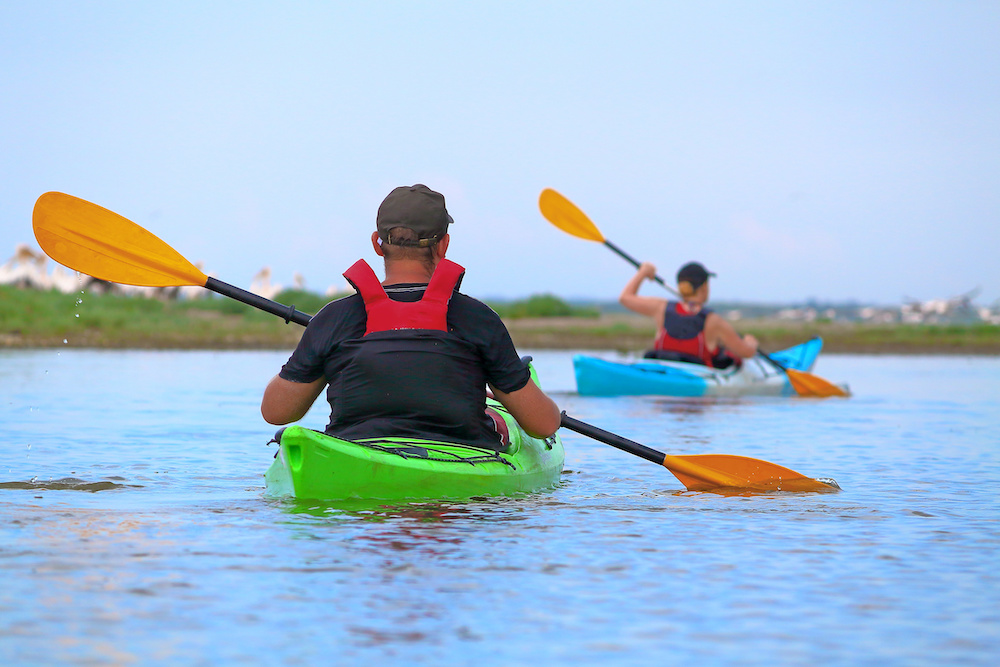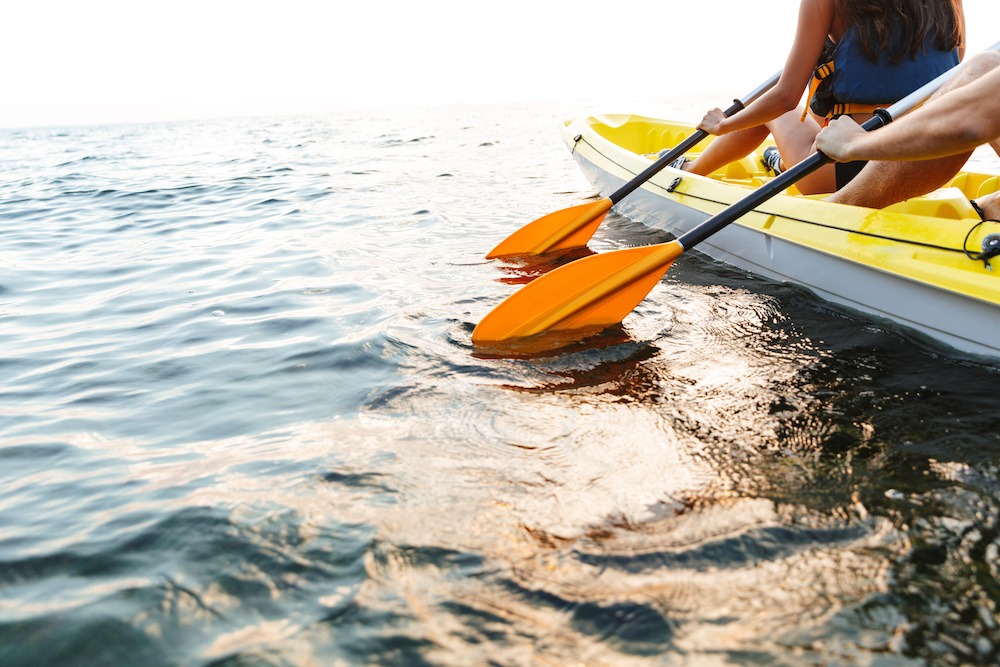How to Choose a Kayak Paddle: A Guide to Selecting the Correct Size
We may earn a commission for purchases using our links. As an Amazon Associate, we earn from qualifying purchases.
Whether you like it or not, paddle size matters.
Sure, you might be able to move across the water comfortably enough using a random paddle, but that doesn’t mean you’ll enjoy doing it for hours.
A paddle not meant for you or your kayak will eventually lead to some sore muscles and less productivity.
Today, we’ll look at some important factors on how to choose a kayak paddle.
This way you can land one that’s just right for you in every way.
What Should I Look for When Buying a Kayak Paddle?
Outside of your kayak, the piece of equipment most influential to your performance in the water is the paddle.
Even a short tour entails at least a couple of thousand strokes, which tells you how critical a good paddle is to your journey.
Factors to Consider
Choosing a kayak paddle isn't an easy task since there are a lot of options and things to consider, such as the following:
- Paddle Length: This is influenced by your height and the width of your vessel.
- Blade Choice: Deals with the blade's size and shape and how these affect the blade’s overall efficiency.
- Price and Materials: A more expensive paddle will usually be lighter, and therefore, better.
- Shaft Choice: A shaft bent or blades that are feathered usually improve overall effectiveness.
While there’s no doubting how crucial these elements play a part in choosing a kayak paddle correctly, everything starts with knowing what size paddle to choose.
What Size of Kayak Paddle Do I Need?
There’s actually nothing complicated about choosing the right paddle size or length.
It mostly involves following one general rule, which is the wider your vessel, the longer your paddle.
That said, your height also comes into play where paddle size selection is concerned.
It is a significant consideration if you’re using a narrower kayak.
Basically, a taller paddler would require a longer paddle.
Then, you also want to consider paddling techniques. Are you a low- or high-angle paddler?
Should you find paddle sizing complicated, feel free to ask any of the experts you can find in outdoor shops.
You might even find these individuals holding demos on different paddle-kayak combinations.
It should help you get a feel for what suits you best.
Nevertheless, paddle sizing is quite simple and involves knowing the answers to the following questions:
How Do You Pick a Kayak Paddle Length Based on Torso Height?
Your torso height should also give you an idea of the paddle size to go for.
Here’s how you can measure yours correctly:
Step #1
Bending your head, try to find the spot where your shoulders and neck meet. That area is called your vertebra.
Step #2
Next, you should locate the end of your torso by measuring your lumbar region.
You can do this by positioning your hands on your hip bones with the thumbs pointing backward and index fingers pointing forward.
Step #3
Ask someone to measure how long the distance is from the top of your vertebra down to your lumbar region.
Step #4
Lastly, round off the figure you come up with to the nearest inch, then assess for the paddle size using the guide below:
- 180 cm Paddle: 22 inches (youth)
- 200 cm Paddle: 24 inches
- 210 cm Paddle: 26 to 28 inches
- 220 cm Paddle: 28 to 30 inches
- 240 cm Paddle: 30 to 32 inches
- 250 cm Paddle: 34 to 38 inches

How Do I Know What Size Paddle I Need for My Kayak?
We’ve already established that finding out how to choose kayak paddles involves measuring your kayak's width.
You can do this accurately by measuring your boat’s widest point.
Generally, when you have a wider kayak, the longer the paddle you will need to dig into the water on both sides efficiently.
You mustn’t also feel strained while doing this. That’s part of how you know you’re using the right paddle.
Once you come up with an accurate measurement, you need to factor that figure in your calculation of the ideal paddle length for your body.
Don’t forget to compare it with other factors, such as your paddling technique and torso height.
How to Choose Kayak Paddle Based on Body Height?
You can use either the height of your body or the height of your torso for coming up with the correct paddle size.
While body height is the system most would recommend, you could find a more accurate match when you supplement this with your torso height.
So, it’s imperative that you still compute both measurements.
Basically, you want to round your height off to the nearest inch, then compare it to the kayak’s width to find the corresponding paddle size.
Use the following for guidance:
- 5ft. 5 inches with a 23-Inch Wide Kayak: 210 cm paddle
- 5ft. 5 inches with a 24 to 32-Inch Wide Kayak: 220 cm paddle
- 5ft. 5 inches with a 29 to 33-Inch Kayak: 230 cm paddle
- 5ft. 5 inches with a 34-Inch or Wider Kayak: 240 cm paddle
- Between 5ft. 5 inches and 5ft. 11 Inches with a 23-Inch Wide Kayak: 230 cm paddle
- Between 5ft. 5 inches and 5ft. 11 inches with a 24 to 32-Inch Wide Kayak: 240 cm paddle
- Between 5ft. 5 inches and 5ft. 11 inches with a 29 to 33-Inch Wide Kayak: 250 cm paddle
- Between 5ft. 5 inches and 5ft. 11 inches with a 34-Inch or Wider Kayak: 260 cm paddle
How to Buy a Kayak Paddle Based on Your Paddling Method?
As telling as torso height, body height, and kayak width are for determining paddle size, you don’t want to forget to incorporate the paddling method to get the closest possible paddle-size match.
The labels on paddles will usually indicate whether they’re for high- or low-angle paddling.
- Low-Angle Paddling
When paddlers use low, horizontal strokes, that’s called low-angle paddling.
It’s typically used by those who are kayaking for relaxation more than anything else.
You’re neither in a race, nor do you have hungry mouths at home waiting for your catch, so there’s no need to rush.
Low-angle paddling doesn’t require you to exert as much strength or expend stamina as much as the high-angle version.
When paddling using a low angle, your paddle’s leverage tilts the shaft slightly, while the hand that leads levels with your shoulder at all times.
Using this paddling technique allows you to have a more fun time in the water.
However, for the kind of fun that gets your pulse racing, go for the high-angle paddling technique.
- High-Angle Paddling
If you want to cut through the water rapidly, then high-angle paddling should be your go-to stroke.
The strokes you use for this technique are shorter, more precise, and more rigorous than the low-angle method.
You also reach into the water nearest the boat to perfect this type of motion.
You want to go for paddles with wider blades and shorter shafts if you’re fond of this technique.
That's because they cut through the water more smoothly, complementing your high-angle strokes.
Paddlers who go for high-angle movements are typically into racing, kayaking adventures, whitewater touring, and other kayaking activities that involve lots of speed.
How to Buy a Kayak Paddles: Materials and Design
The materials that compose your paddle matters as much as its length.
As such, when choosing a paddle, consider the materials used in its blade and shaft, as well as its design.
What Are Your Paddle and Shaft Options?
The material that makes up your paddle blade contributes immensely to your performance in the water.
It also influences how well you’re able to handle the tool.
Here are some common paddle blade materials to choose from:
- Aluminum
This is an excellent option for those who are just beginning their kayaking journey.
Aluminum is a material that’s affordable and of relatively good quality.
However, you will find that paddles made of this material are a bit on the heavier side, making them a little troublesome to handle for some paddlers.
- Carbon Fiber
Otherwise known as graphite, carbon fiber paddles are among the most lightweight on the market.
Expect them to come with a considerable price tag for all the advantages they hold over the rest of your options.
- Fiberglass
One of the few materials that can hold a candle is fiberglass.
That’s because it’s not just lightweight; it’s also durable.
One of the best things about this type of paddle is that it won’t make you break the bank.
- Plastic
This is another material that’s great for beginner kayakers.
While it’s not the best paddle to look at, it is lightweight and affordable enough to get you through the first parts of your journey with ease.
- Wood
What’s great about a wood paddle is its strength and sturdiness.
Of course, one of the downsides to choosing this option is that it’s likely going to cost a pretty penny.
How to Choose a Kayak Paddle Correctly
Now that you know what factors go into choosing a kayak paddle that meets your needs, you should be able to go through the selection process with minimal issues.
When you know how to choose a kayak paddle correctly, not only should you find kayaking easier, but you could also help yourself become the most efficient kayaker you can be.

